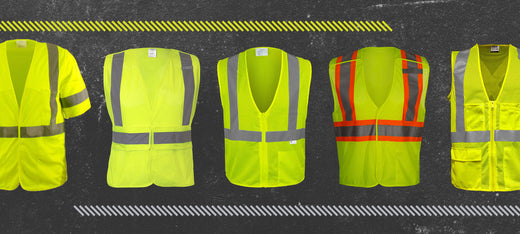Safety vests serve as a first line of defense in hazardous environments, ensuring workers remain visible and protected. However, not all safety vests are created equal. Understanding the key differences between safety vest classes is essential for choosing the right gear for your team or project.
Why Understanding Safety Vest Classes Matters
Safety vest classes provide a standardized system to match visibility gear with specific workplace risks. Selecting the right class from low-risk environments to high-speed traffic zones ensures workers are adequately protected while meeting OSHA and ANSI standards. Wearing the appropriate vest can mean the difference between life and death in certain industries, such as construction, utility work, and emergency response.
Key reasons safety vest classes matter:
- Improved Visibility: Enhanced reflective materials ensure visibility in poor lighting conditions.
- Compliance with Standards: ANSI and OSHA regulations mandate specific visibility levels for certain job roles.
- Operational Efficiency: Safety vests signal adherence to safety protocols, reducing confusion in high-risk environments.
The Three Safety Vest Classes
Class 1 Safety Vests
Class 1 vests are designed for low-risk, non-roadway environments where the workers are off-road. These vests provide basic visibility for workers in controlled settings.
Features:
- Bright neon colors like yellow or orange
- Minimum of 155 square inches of reflective striping
- Simple, lightweight design
Common Uses:
- Parking attendants
- Warehouse staff
- Delivery drivers in low-traffic areas
While sufficient for minimal risks, Class 1 vests are unsuitable for higher-speed or complex environments.
Class 2 Safety Vests
Class 2 safety vests are ideal for medium-risk work settings, such as roads with traffic moving at 25 to 50 mph or areas with heavy machinery.
Features:
- Highly visible neon background fabric
- Minimum of 201 square inches of reflective material
- Enhanced coverage for improved visibility
Common Uses:
- Construction crews
- Utility workers
- Roadside maintenance teams
Class 2 vests offer a balance of visibility and functionality, making them a staple in the construction and maintenance industries.
Class 3 Safety Vests
Class 3 safety vests provide the highest level of visibility, ensuring safety in high-risk environments with traffic speeds exceeding 50 mph or low-light conditions.
Features:
- Full-body coverage with reflective strips on the torso, shoulders, and sleeves.
- Minimum of 310 square inches of reflective material.
- Designed for maximum visibility in all conditions.
Common Uses:
- Emergency responders.
- Surveyors on highways.
- Operators of heavy machinery in dimly lit areas.
Class 3 vests exceed all visibility requirements and are indispensable in the most hazardous settings.
Choosing the Right Safety Vest
Selecting the appropriate safety vest requires careful consideration of the work environment, task requirements, and regulatory standards. Here are key factors to guide your decision:
- Work Environment: Consider hazards such as vehicle speed, lighting conditions, and proximity to machinery.
- Regulatory Compliance: Ensure vests meet ANSI and OSHA standards for your industry.
- Job-Specific Needs: Match vest features to specific tasks, e.g., Class 3 vests for night highway projects.
- Durability and Comfort: Opt for vests made from durable materials with adjustable fits.
Best Practices for Safety Vest Use and Maintenance
- Inspection: Check for wear, rips, or fading reflective materials before use.
- Cleaning: Follow the manufacturer’s washing instructions to preserve color and reflectivity.
- Replacement: Replace vests with significant wear or reduced visibility.
- Proper Fit: Ensure vests fit snugly over clothing without restricting movement.
- Visibility Maintenance: Keep reflective materials unobstructed, even when layering with jackets.
Equip Your Team with Confidence
Investing in the right safety gear is not just a regulatory requirement—it’s a commitment to protecting lives and enhancing workplace efficiency. High-visibility safety apparel, such as ANSI-compliant vests, provides a vital layer of protection in environments where visibility is crucial. By equipping your team with the appropriate safety gear, you foster a safer, more productive work environment.
Frequently Asked Questions
What Is The Difference Between Class 1, 2, and 3 Safety Vests?
Class 1 vests are for low-speed, low-risk environments. Class 2 vests are for moderate risks, such as traffic up to 50 mph. Class 3 vests are for high-risk settings with high-speed traffic or low-light conditions.
What Are The Requirements For Class 2 Safety Vests?
Class 2 vests must have a minimum of 201 square inches of reflective material and a neon background for enhanced visibility.
When Should Class 3 Safety Vests Be Used?
Use Class 3 vests in high-speed traffic zones (50 mph+) or environments with poor lighting or adverse weather conditions.
What Are Breakaway Safety Vests, and Who Should Use Them?
Breakaway vests are designed to tear away easily if caught on equipment. They are ideal for workers who are around moving machinery.
Do you have any non-ANSI High Visibility Vests?
Yes, we offer non-ANSI high visibility vests for low-risk settings, such as event staff or volunteers. Check out our Enhanced Visibility Vests collection for great options.







